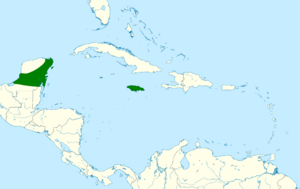Caribbean dove facts for kids
Quick facts for kids Caribbean dove |
|
|---|---|
 |
|
| Conservation status | |
| Scientific classification | |
| Genus: |
Leptotila
|
| Species: |
jamaicensis
|
 |
|
| Synonyms | |
|
Columba jamaicensis Linnaeus, 1766 |
|
The Caribbean dove (Leptotila jamaicensis) is a beautiful bird that belongs to the Columbidae family, which includes pigeons and doves. You can find this bird in places like Belize, the Cayman Islands, parts of Colombia (like San Andrés island), Honduras (Bay Islands), Jamaica, and Mexico (Yucatán Peninsula). It has also been brought to the Bahamas.
Contents
About the Caribbean Dove's Name
Have you ever wondered how animals get their names? For the Caribbean dove, it's a cool story! In the 1700s, several naturalists, who are scientists who study nature, described this bird. They often called it the "white-bellied dove."
Later, in 1766, a famous Swedish scientist named Carl Linnaeus gave the bird its official scientific name: Columba jamaicensis. He was the one who created the system we still use today to name living things, called binomial nomenclature. This system gives every species two names, like a first and last name.
Today, the Caribbean dove is placed in a different group, or genus, called Leptotila. This change happened in 1837 thanks to an English naturalist named William Swainson. Scientists have also found that the Caribbean dove is closely related to another bird called the white-tipped dove.
What are Subspecies?
Just like people can have different looks depending on where they come from, animals can have subspecies. These are groups within a species that have slight differences, often because they live in different areas. The Caribbean dove has four known subspecies:
- L. j. collaris
- L. j. gaumeri
- L. j. jamaicensis
- L. j. neoxena
What Does the Caribbean Dove Look Like?
The Caribbean dove is a medium-sized bird, usually about 29 to 33 centimeters (11 to 13 inches) long. It weighs between 117 and 190 grams (4.1 to 6.7 ounces).
Colors and Features
Adult male Caribbean doves have a white forehead, face, and throat. The back of their head is gray, and their neck shines with purple colors. Their shoulders and the sides of their neck are a rosy red, with shimmery green or purple hints. The whole underside of the bird is white.
The upper parts of its body are olive-brown. When its wings are folded, you can see a white band in front of them. The inner tail feathers are grayish-brown, while the outer ones are black with white tips. Its eye is white, sometimes with a red ring, and is surrounded by dull purple skin. Its legs and feet are red.
Female doves look similar to males but have less bright, shimmery colors. Young doves, called juveniles, are also similar to adults but are duller. Many of their feathers have reddish edges.
Differences in Subspecies
The different subspecies have small variations:
- L. j. collaris is generally a bit smaller than the main subspecies.
- L. j. gaumeri is also slightly smaller. Its upper body is a darker olive, its chest has a reddish tint, and its shimmery colors are not as bright.
- L. j. neoxena is in between the main subspecies and L. j. gaumeri in size and color.
Where Do Caribbean Doves Live?
Caribbean doves live in different places depending on their subspecies:
- L. j. collaris lives in the Cayman Islands.
- L. j. gaumeri is found in Mexico's northern Yucatán Peninsula, including islands like Isla Mujeres and Cozumel. It also lives in Belize's Ambergris Caye and some islands off Honduras.
- L. j. jamaicensis lives in Jamaica and has been introduced to New Providence in the Bahamas.
- L. j. neoxena lives on Colombia's San Andrés island.
These doves prefer dry, low-lying areas with some shrubs or trees. In Jamaica, they like dry limestone forests, especially areas where trees have grown back after being cut down. They can be found as high as 2,000 meters (6,600 feet) in the Blue Mountains.
How Do Caribbean Doves Behave?
What Do They Eat?
Caribbean doves look for their food on the ground. In Jamaica, people have seen them eating seeds and small snails.
How Do They Raise Their Young?
The Caribbean dove's breeding season is from March to May. They usually build their nests low to the ground in a tree or bush. Sometimes, they might nest higher up or even on the ground. A female dove usually lays two eggs at a time.
What Does Their Song Sound Like?
The Caribbean dove's song is a rhythmic series of four sad-sounding notes. The last note is the longest and most emphasized. It sounds like "wo-o-o-oooooo."
Conservation Status
The IUCN (International Union for Conservation of Nature) has evaluated the Caribbean dove's status. They have listed it as "Least Concern." This means that even though it might not be very common on some smaller islands, its overall population is stable. It is quite common in Jamaica and very common in the Yucatán Peninsula.


